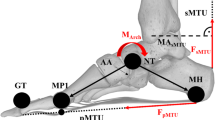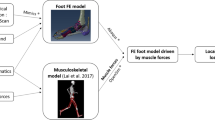Abstract
The purpose of this study was to determine if lower extremity joint loading was influenced by stride length or shoe midsole cushioning. Ten subjects completed 10 trials of overground running at an average speed of 4.43 m/s in each of three conditions: normal running, running with a stride length (SL) reduced by 10% of normal, and running with a cushioned midsole stiffness (i.e., mechanical impact reduction of 13.7–10.9 g). Reaction forces calculated from inverse dynamics were summed with muscle forces estimated from a musculoskeletal model using static optimization to obtain joint contact forces at the hip, knee and ankle joints. Peak components of the contact forces [axial, anterior–posterior, and medial–lateral (ML)] were examined using parametric statistics (α = 0.05). Reducing stride length resulted in significant decreases in absolute peak ankle contact forces in the axial direction (normal: − 14.5 ± 1.5 BW; reduced SL: − 14.0 ± 1.6 BW) and the ML direction (normal: 0.67 ± 0.23 BW; reduced SL: 0.61 ± 0.21 BW). Reducing stride length also reduced the peak absolute axial forces at the knee (normal: − 10.6 ± 1.3 BW; reduced SL: − 9.8 ± 1.2 BW) and the hip (normal: − 7.26 ± 2.24 BW; reduced SL: − 6.75 ± 2.10 BW). The cushioned shoe did not statistically reduce the peak absolute contact forces from the normal stride condition at any of the joints. Post hoc stress analysis suggested that the observed changes in anterior hip force would increase stress more than any of the other statistically significant results. Reductions in stride length appear to decrease some joint contact variables but cushioning in the heel region of the shoe does not.




Similar content being viewed by others
References
Almeida SA, Williams KM, Shaffer RA, Brodine SK. Epidemiological patterns of musculoskeletal injuries and physical training. Med Sci Sports Exerc. 1999;31(8):1176–82.
Arendt E, Agel J, Heikes C, Griffiths H. Stress injuries to bone in college athletes: a retrospective review of experience at a single institution. Am J Sports Med. 2003;31(6):959–68.
Arnold EM, Ward SR, Lieber RL, Delp SL. A model of the lower limb for analysis of human movement. Ann Biomed Eng. 2010;38(2):269–79.
ASTM F. Standard test method for cushioning properties of athletic shoes using an impact test. American Society for Testing and Material. 1976.
Bennell KL, Malcolm SA, Thomas SA, Wark JD, Brukner PD. The incidence and distribution of stress fractures in competitive track and field athletes: a twelve-month prospective study. Am J Sports Med. 1996;24(2):211–7.
Brunet ME, Cook SD, Brinker MR, Dickinson JA. A survey of running injuries in 1505 competitive and recreational runners. J Sports Med Phys Fit. 1990;30(3):307–15.
Burdett RG. Forces predicted at the ankle during running. Med Sci Sports Exerc. 1982;14(4):308–16.
Cavanagh PR, Lafortune MA. Ground reaction forces in distance running. J Biomech. 1980;13(5):397–406.
Cohen J. Statistical power analysis for the behavioral sciences. L. Lawrence Earlbaum Associates: Hillsdale; 1988. p. 2.
Croker SL, Clement JG, Donlon D. A comparison of cortical bone thickness in the femoral midshaft of humans and two non-human mammals. HOMO – J Comp Hum Biol. 2009;60(6):551–65.
Crowninshield RD, Brand RA. A physiologically based criterion of muscle force prediction in locomotion. J Biomech. 1981;14(11):793–801.
Davis IS, Bowser BJ, Mullineaux DR. Greater vertical impact loading in female runners with medically diagnosed injuries: a prospective investigation. Br J Sports Med. 2016;50(14):887–92.
Derrick TR, Hamill J, Caldwell GE. Energy absorption of impacts during running at various stride lengths. Med Sci Sports Exerc. 1998;30(1):128–35.
Edwards WB. Modeling overuse injuries in sport as a mechanical fatigue phenomenon. Exerc Sport Sci Rev. 2018;46(4):224–31.
Edwards WB, Gillette JC, Thomas JM, Derrick TR. Internal femoral forces and moments during running: implications for stress fracture development. Clin Biomechan. 2008;23(10):1269–78.
Edwards WB, Taylor D, Rudolphi TJ, Gillette JC, Derrick TR. Effects of stride length and running mileage on a probabilistic stress fracture model. Med Sci Sports Exerc. 2009;41(12):2177–84.
Glitsch U, Baumann W. The three-dimensional determination of internal loads in the lower extremity. J Biomech. 1997;30(11–12):1123–31.
Meardon SA, Willson JD, Gries SR, Kernozek TW, Derrick TR. Bone stress in runners with tibial stress fracture. Clin Biomech. 2015;30(9):895–902.
Meardon SA, Willson JD, Kernozek TW, Duerst AH, Derrick TR. Shoe cushioning affects lower extremity joint contact forces during running. Footwear Sci. 2018;10(2):109–17.
Miller RH, Hamill J. Computer simulation of the effects of shoe cushioning on internal and external loading during running impacts. Comput Methods Biomech Biomed Eng. 2009;12(4):481–90.
Nigg BM, Herzog W, Herzog W. Biomechanics of the musculo-skeletal system, vol 192. New York: Wiley; 1999.
Rooney BD, Derrick TR. Joint contact loading in forefoot and rearfoot strike patterns during running. J Biomech. 2013;46(13):2201–6.
Sasimontonkul S, Bay BK, Pavol MJ. Bone contact forces on the distal tibia during the stance phase of running. J Biomech. 2007;40(15):3503–9.
Scott SH, Winter DA. Internal forces of chronic running injury sites. Med Sci Sports Exerc. 1990;22(3):357–69.
Shorten M, Mientjes MI. The ‘heel impact’ force peak during running is neither ‘heel’ nor ‘impact’ and does not quantify shoe cushioning effects. Footwear Sci. 2011;3(1):41–58.
Söderkvist I, Wedin PÅ. Determining the movements of the skeleton using well-configured markers. J Biomech. 1993;26(12):1473–7.
Vaughan CL, Davis BL, Jeremy CO. Dynamics of human gait. Champaign: Human Kinetics; 1992. p. 17–22.
Author information
Authors and Affiliations
Corresponding author
Rights and permissions
About this article
Cite this article
Thomas, J.M., Edwards, W.B. & Derrick, T.R. Joint Contact Forces with Changes in Running Stride Length and Midsole Stiffness. J. of SCI. IN SPORT AND EXERCISE 2, 69–76 (2020). https://doi.org/10.1007/s42978-019-00027-3
Received:
Accepted:
Published:
Issue Date:
DOI: https://doi.org/10.1007/s42978-019-00027-3




